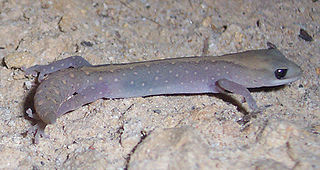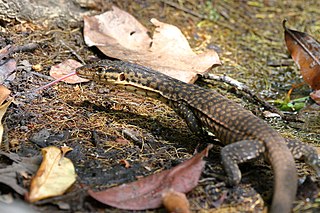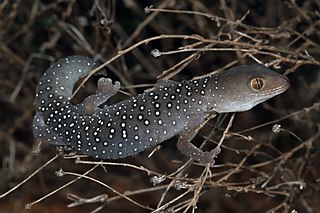
Diplodactylus is a genus of geckos of the family Diplodactylidae from Australia. They are sometimes called stone geckos or fat-tailed geckos. Member species are morphologically similar but genetically distinct.
The south-western spiny-tailed gecko, also known commonly as the soft spiny-tailed gecko, is a species of lizard in the family Diplodactylidae. The species is endemic to Australia. Two subspecies are recognized.
The Pilbara monitor, also known as Bush's monitor, is a species of monitor lizard in the family Varanidae. The species is endemic to Australia.

Mitchell's water monitor is a semiaquatic species of monitor lizard in the family Varanidae. The species is native to Australia.
Lucasium steindachneri, commonly called the box-patterned gecko or Steindachner's gecko, is a species of nocturnal, medium-sized lizard in the family Diplodactylidae. The species has a pale strip with three patches of brown along its back. This gecko is terrestrial and only found in arid and semi-arid areas of continental Australia.
Lucasium byrnei, commonly known as the gibber gecko or Byrne's gecko, is a species of small, nocturnal gecko, a lizard in the family Diplodactylidae. The species is endemic to Australia.
Diplodactylus fulleri, sometimes called the Lake Disappointment ground gecko, is a species of gecko, a lizard in the family Diplodactylidae. The species is endemic to Australia.
Diplodactylus kenneallyi, sometimes called commonly Kenneally's gecko, is a species of gecko, a lizard in the family Gekkonidae. The species is endemic to Australia.
Diplodactylus klugei is a species of gecko, a lizard in the family Gekkonidae. The species is endemic to Australia.
Diplodactylus savagei, known commonly as the yellow-spotted Pilbara gecko, is a species of lizard in the family Diplodactylidae. The species is endemic to Australia.

Main's ground gecko is a species of gecko, a lizard in the family Diplodactylidae. The species is endemic to Australia.

Strophurus elderi, also known as the jewelled gecko, is a species of gecko, a lizard in the family Diplodactylidae. The species is endemic to Australia.
Strophurus jeanae, also known commonly as the southern phasmid gecko and Jean's spiny-tailed gecko, is a species of gecko, a lizard in the family Gekkonidae. The species is endemic to Australia.
The short-tailed striped gecko, also known commonly as McMillan's spiny-tailed gecko, is a species of lizard in the family Diplodactylidae. The species is endemic to Australia.

The Exmouth spiny-tailed gecko, also known commonly as Rankin's spiny-tailed gecko, is a species of lizard in the family Diplodactylidae. The species is endemic to Western Australia.
Strophurus robinsoni is a species of gecko, a lizard in the family Diplodactylidae. The species is endemic to Australia.

Strophurus taenicauda, also known commonly as the golden spiny-tailed gecko or the golden-tailed gecko, is a species of lizard in the family Diplodactylidae. The species is endemic to eastern Australia. Three subspecies are recognized.
The Western Shield spiny-tailed gecko, also known commonly as Wellington's spiny-tailed gecko, is a species of lizard in the family Diplodactylidae. The species is endemic to Australia.
The Mount Augustus spiny-tailed gecko, also known commonly as the Mount Augustus striped gecko, is a species of lizard in the family Diplodactylidae. The species is endemic to Australia.





